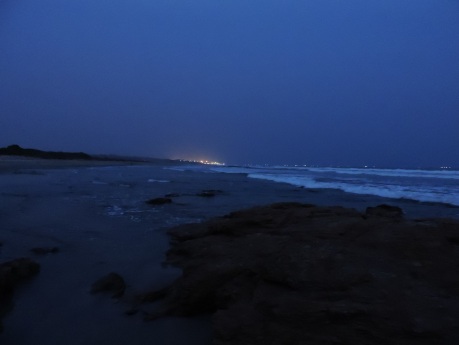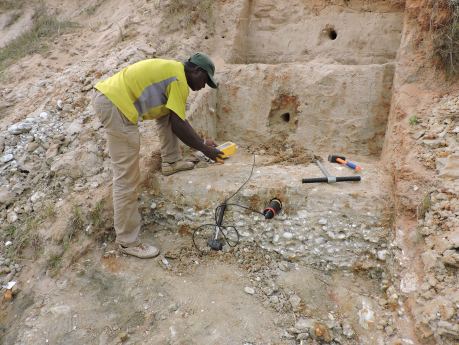Our pilot archaeological project is now coming to end, on the fieldwork side. Dating specialist Professor Geoff Duller arrived on Tuesday night and for four days the team has been busy helping with the collection of sand samples for luminescence dating. I’ll explain this dating method shortly, but first let’s look at the process of extracting the samples from the ground.
Geoff and I discuss where to collect the samples to ensure we’re targeting key archaeological horizons – like the Sangoan – and the sediments above and below to help bracket the age of the artefacts. A tube of plastic or steel with a bevelled edge is hammered into the section face. The plastic tubes are used on the soft sands that occur at the top of the Asokrochona sequence and in much of the coastal cliff sequence at the former Nautical College. The steel tubes are reserved for the hard older deposits at Asokrochona and the base of the Nautical College.
Geoff brought a dense rubber mallet but it wasn’t up to the job of driving the steel into the key Sangoan deposits at either site. We needed something heavy-duty like a sledge-hammer.
Siaw and Seth (our driver) sped off to find a sledge hammer in the local shops. They returned with a foot-long iron-tipped miniature sledge-hammer that cost less than £5 ($7.50). If a bargain is too good to be true then it probably is and this tool was no exception. Within minutes the head had come off. We had a good laugh – followed by a few choice words about the poor quality of manufacture. But, the head was tapped back on and eventually, with careful pounding, the tube was well into the Asokrochona Formation – our key deposit at the site because of its concentration of large tools.
Geoff’s first day on site was a shock to his system. The baking heat was joined with odorous wafts of excrement and food waste drifting over from the village across the tracks. I recall lasting about two hours on my first day at Asokrochona before feeling dizzy from the heat. Geoff was right on schedule with a wobble mid-morning followed by a recuperative spell of shade in the car.
We were on a tight schedule this final week and prolonged wobbling from any team member would not be good. Part of the time pressure came from a planned site visit by postgraduate students at the University of Ghana led by the well-respected archaeologist Professor James Anquandah. The Professor had last been here in 1964 and was keen to see that new work was underway at the site to address the vexing issue of its age. The visit would take place Thursday, our last field day at both sites.
Sections still needed drawing and Geoff and I had offered to give a joint presentation on Friday to the Archaeology Department and invited guests from the University and the Museum and Monuments Board. We worked on the presentation long into the night on Wednesday and Thursday. In addition, I had to finish the analysis of the artefacts we’ve collected because that had to be handed over to the Museum on Friday, and Geoff would need an export permit for the dating samples.
The final twist of the screw came from the dating sampling process – it’s slow.
After a sampling tube has been extracted and carefully packaged, then the background radiation has to be measured using a portable gamma ray dosimeter. Geoff will calculate when the sands grains were last exposed to sunlight before being buried. Exposure to modern sunlight just for a few seconds could spoil the results by resetting the electron traps in the individual grains of quartz sand. That would be VERY BAD, especially after the months of effort it’s taken to get to this final stage of the fieldwork.
As Geoff explained to the student visitors, the electron traps act like a battery that’s being charged in your phone or laptop. The length of time it took to fill the electron traps can be calculated to give an age since the last exposure and that calculation involves the dosimetry readings from the sample site. If your phone battery is fully charged you just can’t add any more power however long you leave it being charged. The same happens to quartz grains and with this technique (called Optically Stimulated Luminescence) ‘saturation’ is often reached after 150,000 years or so.
That time span will be fine for dating the recent upper part of the Asokrochona sequence, and I suspect for most of the Nautical College deposits, but not for the lower deposits with Sangoan artefacts. If that’s the case, then Geoff will switch to a newer more experimental version of the technique called Thermally-Transferred Optically Stimulated Luminescence (TT-OSL). I won’t explain how this works, other than to say it measures a more slowly growing signal in the quartz, which means the age range can be extended greatly. Geoff has applied it with some success to another site we worked on together – Kalambo Falls, Zambia. There it extended the age range back to 500,000 years ago and so it should help us get a fix on the earliest part of the Asokrochona record.
It’s now time for patience on my part as the analytical work will take some months to complete, back in the lab at Aberystwyth University.
We had planned to collect a total of six dating samples from each site, which was feasible if all went smoothly. It didn’t. Too many artefacts in the sediment prevented the collection of second sample from the Sangoan at Asokrochona – which was a disappointment. A steel tube couldn’t be hammered in because of the density of artefacts (which I added to my collection of pieces to analyse by Friday).
In addition, the Departmental site visit ended up taking much longer than planned because of the sheer interest of the students and Professor Anquandah in the project. One student helpfully suggested that we work at night to reduce the risk of light contamination. It turned out to be a prophetic suggestion …
It was midday when we finally arrived at the Nautical College with all the sampling still to do. We would in fact finish in the dark with the lights of Tema port glowing to the east.
As so often happens on archaeological digs the best finds came in the final hours of the project. While waiting for a dosimetry session to end, I went for a stroll with George Anorchie, our officer from the Museum. We headed towards the very last remnants of the Nungua Formation (Middle Stone Age) that survive on this stretch. Here we saw a large white quartz artefact emerging from the deposit. It turned out to be the longest flake from the site and joined a collection of other large pieces from cobbles overlying bedrock. Is this more Sangoan?
Then Geoff and I walked in the other direction and, as the light faded, he noticed a deposit of clayey sand beneath the cobbles – something we hadn’t seen in the main section of the cliff. Out came the last of the steel tubes and by the time we left after the dosimetry readings were made it was definitely dark. I don’t think nocturnal archaeology will catch on, but when pushed by deadlines, needs must.

The Port of Tema glows in the distance, lights of ships shine in the dark as our nocturnal archaeoology draws to a close
I’ll miss that beach. Despite all the flotsam washed ashore from the shipping trade – and the excrement deposited daily by visitors (yes, here too) – the cooling breeze made it a comfortable place to work. And of course the artefacts were intriguing for being dispersed rather than concentrated as at Asokrochona.
I’ll be back with more posts once we have some results on the dates. It may be a while, so if you don’t want to keep checking back you might want to ‘Follow’ so you’ll receive a notification when a new post is published.
Thank you for reading.





